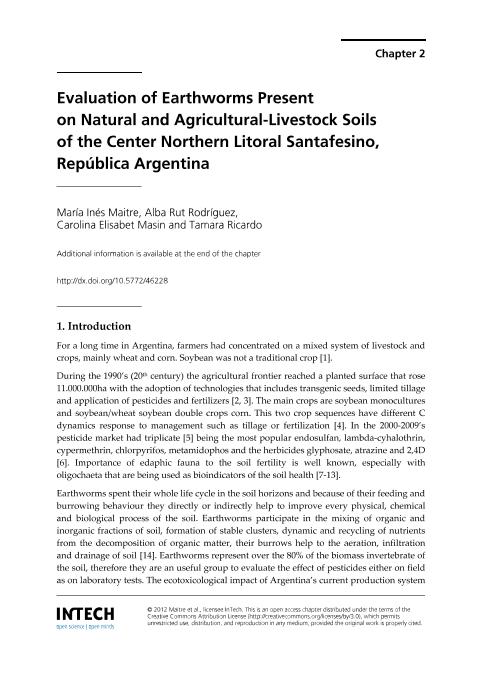Capítulo de Libro
Evaluation of Earthworms Present on Natural and Agricultural-Livestock Soils of the Center Northern Litoral Santafesino, República Argentina
Título del libro: Pesticides: Advances in Chemical and Botanical Pesticides
Maitre, Maria Ines ; Rodríguez, Alba Rut; Masin, Carolina Elisabet
; Rodríguez, Alba Rut; Masin, Carolina Elisabet ; Ricardo, Tamara
; Ricardo, Tamara
 ; Rodríguez, Alba Rut; Masin, Carolina Elisabet
; Rodríguez, Alba Rut; Masin, Carolina Elisabet ; Ricardo, Tamara
; Ricardo, Tamara
Otros responsables:
Soundararajan, R.P.
Fecha de publicación:
2012
Editorial:
IntechOpen
ISBN:
978-953-51-0680-7
Idioma:
Inglés
Clasificación temática:
Resumen
Importance of edaphic fauna is well known, especially earthworms that are used as bioindicators of soil health (Pérès et al., 2011; Masin et al., 2011; Simonsen et al., 2010; Capowiez et al., 2010; Zerbino et al., 2006; Momo et al., 1993). Earthworms spent their whole life cycle on soil horizons and because of their feeding and burrowing behaviour they directly or indirectly help to improve every physical, chemical and biological process from the soil. Earthworms participate in the mixing of organic and inorganic fractions of the soil, formation of stable clusters, dynamic and recycling of nutrients from the decomposition of organic matter, their burrows help to the aireation, infiltration and drainaige of the soil (Ouellet et al., 2008). Earthworms represent over the 80% of the biomass invertebrate from the soil, therefore they are an useful group to evaluate the effect of pesticides either on field as on laboratory tests. In Argentina, since the 1990?s (20thcentury) the agricultural frontier passed the 11.000.000ha, requiring the application of technologies that include genetically modified seeds and pesticides application (Pengue, 2005). The main crop is transgenic soybean and the most used insecticides are endosulpham, lambda-cyhalothrin, cypermethrin, chlorpyriphos and methamidophos (CASAFE, 2009). Between 2000-2009 the insecticide usage triplicated to control lepidoptera and hemiptera soybean?s parasite (Perrotti et al., 2010). Glyphosate, atrazine and 2,4D are the most widely used herbicides in the control of weed at soybean crops. The ecotoxicological impact of this production system is not well know and needs deeper studies using bioindicators to evaluate the risks from anthropogenic alterations (Candela et al., 2010; Evans et al., 2010; Ricardo et al., 2010; Zhao et al. 2009; Albers et al., 2009; Krzysko-Lupicka & Sudol, 2008; Wei et al., 2009; Lupwayi et al., 2009; Nakamura et al., 2008; Jänsch et al., 2005; Förster et al., 2006; Devotto et al., 2007; Wanner et. al., 2004; European Commission, 2001). Because of that, we performed field studies to determine the biomass, richness and density of earthworms and ecotoxicological assays at laboratory.
Palabras clave:
EARTHWORMS
,
SOIL
,
ASSAYS AT LABORATORY
,
PESTICIDE
Archivos asociados
Licencia
Identificadores
Colecciones
Capítulos de libros(INTEC)
Capítulos de libros de INST.DE DES.TECNOL.PARA LA IND.QUIMICA (I)
Capítulos de libros de INST.DE DES.TECNOL.PARA LA IND.QUIMICA (I)
Citación
Maitre, Maria Ines; Rodríguez, Alba Rut; Masin, Carolina Elisabet; Ricardo, Tamara; Evaluation of Earthworms Present on Natural and Agricultural-Livestock Soils of the Center Northern Litoral Santafesino, República Argentina; IntechOpen; 2012; 13-38
Compartir
Altmétricas



